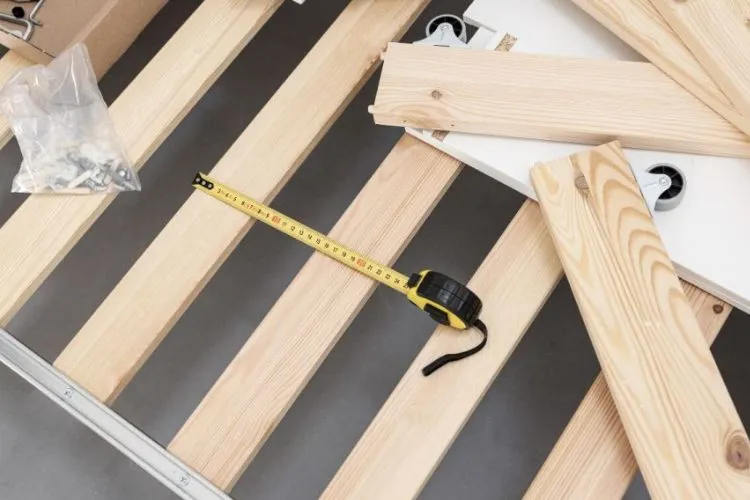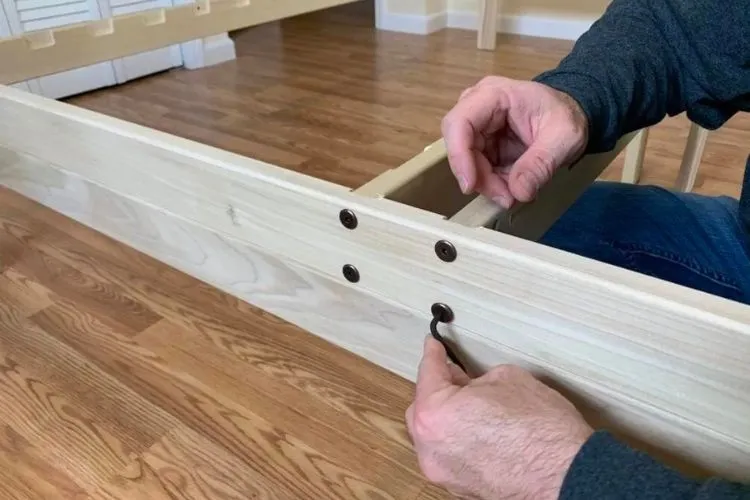When you lie down on your bed after a tiring day, the last thing you want is a squeak or wobble disrupting your comfort—or worse, a bed frame collapse.
Knowing how to reinforce a bed frame not only ensures a peaceful night’s sleep but also extends the life of your bed.

Why To Reinforce a Bed Frame?
The first clue that your bed frame needs attention could be a creaking noise that occurs when you toss and turn. This can indicate loose joints or wear.
If you notice any sagging or feel any movement when you climb into bed, it’s time to inspect for loose or damaged parts. An unstable bed frame not only interrupts sleep but also can lead to mattress damage.
Materials and Tools Needed
To get started, prepare the following basic materials and tools:
- A set of wrenches or screwdrivers matching your bed frame’s hardware
- Wood glue or metal fasteners, depending on your bed frame material
- Replacement screws or bolts, if the existing ones are worn out
- A piece of plywood or metal braces for additional slat support
- A saw for cutting additional supports to size
- A leveler tool to ensure alignment
Gathering these items beforehand will save time and make the process smoother.
How to Reinforce A Bed Frame (A Step-by-Step Guide)
Bed frames are an instrumental part of our bedroom setup as they support our mattresses and, in turn, ensure our comfortable sleep. Over time, these frames might show signs of loosening or instability.
Here’s a step-by-step guide on how you can reinforce your bed frame and make it as sturdy as it was initially.

Step 1: Tightening Loose Bolts and Screws
The first step in this process involves examining your bed frame’s condition. Over time, due to regular usage and natural movement, the screws and bolts holding the bed together may start to loosen. You can correct this by:
- Identifying the loose screws or bolts. Run your hand gently across the frame to spot any protruding parts.
- Use a screwdriver or other suited tools to tighten them effectively.
- For metal frames, consider using thread-locking fluid, which prevents screws and bolts from loosening up by filling gaps around the thread. This adhesive keeps them from unwinding and contributes to overall bed stability.
Step 2: Adding Support to Slats
Bed slats often take on the brunt of the mattress’s weight. This can lead to them bending or even breaking. To reinforce them:
- Consider adding a central support beam. You can acquire one from your local hardware store, or DIY one with a suitable piece of lumber.
- Overlay your slats with a flat, sturdy piece of plywood. This spreads the weight of the mattress more evenly and keeps individual slats from snapping or bending.
- Always ensure the additional components fit snugly but not tightly. Too much tension could cause other parts of the frame to bend or break.
Step 3: Reinforcing Frame Joints
Loose joints are primary contributors to a wobbly bed frame. Reinforcing them is crucial. Depending on your bed frame material:
- For wooden frames, you can utilize wood glue to strengthen the loose connections. Apply it to the joints and clamp them together until the adhesive dries fully.
- Metal frames could benefit from welding, where feasible. Otherwise, additional fasteners can be used to secure the joints. Always wear protective gear when welding and make sure the room is well-ventilated.
Step 4: Checking and Adjusting Bed Frame Alignment
An uneven bed frame can cause uncomfortable sleeping conditions and expedite frame wear. It’s essential to:
- Use a level to verify if the frame is lying flat and evenly. If not, adjust the legs or supporting areas until you get a balanced level.
- Checking the whole frame for alignment ensures an even distribution of weight across the frame, reducing stress on specific parts.
By following these steps, you should have a sturdier and more reliable bed frame, ensuring your safety and a good night’s sleep. Regular maintenance will prolong the life of your bed frame and keep it in prime condition.
Pro Tips for Long-Term Maintenance
Maintaining your bed frame doesn’t just preserve its lifespan but also ensures it continues to provide the support necessary for a restful sleep. Regular check-ups are the key to catching small problems early.
Every few months, give your bed frame a once-over—tighten all screws and bolts with the appropriate tools to keep everything snug and secure. Loose hardware can lead to instability, noise, and increased wear over time.

Assess all parts of the bed frame for signs of wear, such as cracks in wood or bends in metal. Cracks can grow and eventually compromise the structural integrity of the frame, so addressing them immediately with wood glue or other repair methods can prevent further damage.
For metal frames with bent components, consider a professional’s help to straighten or replace the affected part, ensuring the frame maintains the proper shape and support.
Additionally, evaluate the condition of slats and legs. Weight distribution depends largely on these areas, and any weakness can lead to sagging and discomfort.
If a slat is bowed or broken, replace it promptly to maintain the frame’s firm foundation. Including these practices in your routine will not only prolong the life of your bed frame but also contribute to your overall sleep health.
Frequently Asked Questions (FAQs)
How Often Should I Reinforce My Bed Frame?
Inspect your bed frame every six months to a year and reinforce as needed. Keeping ahead of maintenance will ensure your bed remains stable and supportive.
Can I Reinforce Any Type of Bed Frame?
Yes, both wooden and metal bed frames can be reinforced, but the methods and materials will differ. Wood frames often require glue and additional wooden supports, while metal frames might need welding or extra brackets.
What if I Cannot Fix the Bed Frame Myself?
If DIY isn’t for you, consider hiring a professional. This ensures the job is done correctly and your bed frame is safe and secure.
Conclusion:
A sturdy bed frame is a cornerstone of a restful night’s sleep. Following this guide will help you ensure that your bed frame is strong and secure.
Regular checks and maintenance are key. With a bit of effort and attention to detail, you can greatly extend the life of your bed frame, ensuring many nights of peaceful sleep.
By adhering to this guide, you can confidently maintain and reinforce your bed frame, preventing unwelcome disturbances during your rest and prolonging the life of your sleep sanctuary.


